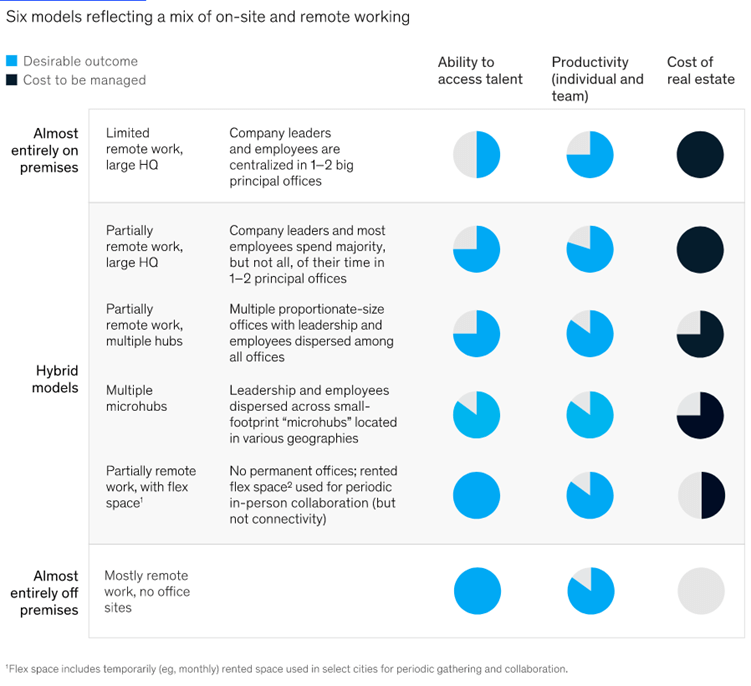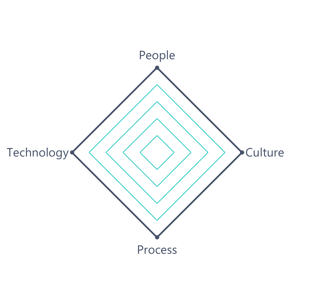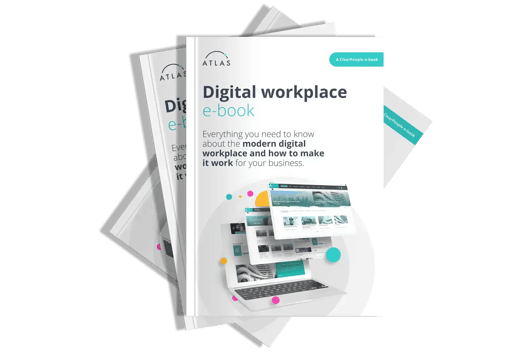Hybrid working is no longer wishful thinking, a trend or a prophecy: hybrid working is happening and companies have to find ways to make it work for them and their people.
Making hybrid working successful
As with any major shift from traditional methods of business to this new practice that can be seen as both beneficial and dangerous at times; careful consideration needs to go into how sustainability will play out in their company culture going forward.
This article covers:
To adopt hybrid working successfully organisations need to think about:
- The need for investment in technology to bridge the gap between the physical and digital worlds
- Combating digital exhaustion
- Rethinking employee experiences to compete for the best and most diverse talent
- Asynchronous working.
Different models of working - office, hybrid and remote only
Let's start with different models for hybrid working.
McKinsey & Company distinguish six different models of hybrid working. The research shows that remote-first organisations have some strong benefits in terms of hiring talent, productivity and cost of real estate. However, different hybrid working models may work best for different environments.

The Hybrid Work Paradox
The Microsoft 2021 Work Trends Index Annual Report has highlighted some interesting revelations with regards to hybrid working. Microsoft’s CEO, Satya Nadella said: “Over the past year, no area has undergone more rapid transformation than the way we work. Employee expectations are changing, and we will need to define productivity much more broadly — inclusive of collaboration, learning, and wellbeing to drive career advancement for every worker, including frontline and knowledge workers, as well as for new graduates and those who are in the workforce today. All this needs to be done with flexibility in when, where, and how people work”.
This internal study by Microsoft shows that while hybrid work is complex, embracing flexibility, different work styles and a culture of trust can help us all navigate it successfully.
While hybrid work will help organisations improve in these areas, finding the balance will be complex. Microsoft's ongoing research shows employees crave more in-person time with their team but wish to keep the flexibility of remote work. And every person is different – 58% of employees who plan to spend the most and least time in-office are doing it for the same reason: more focused work. And there are gaps to fill – managers plan to spend a higher share of their time in-office than non-managerial employees (45% vs. 39%). Moreover, employees surveyed plan to go into the office more than managers expect. This complexity is what Satya calls the Hybrid Work Paradox.
The positives of hybrid working are plentiful
Hybrid working can easily facilitate hiring talent from all over the world. According to Microsoft’s 2021 Work Trends Index Annual Report:
- Remote job postings on LinkedIn have increased more than five times during the pandemic
- Forty-six percent of remote workers are planning to move to a new location this year because they can now work remotely
- People no longer have to leave their desk, house or community to expand their career, and it will have profound impacts on the talent landscape.
With all the above positive considerations, it could be said that the key to successful hybrid working is focusing on a remote-first approach.
Challenges of hybrid working
We cover this topic more extensively in our blog entitled "The most common hybrid workplace challenges" but provided a quick summary to counterbalance the positives of hybrid working.
- Keeping productivity up
- Employee engagement
- Onboarding
- Slowing innovation
What is remote-first?
The definition of remote-first is that the default mode of the organisation is remote. The infrastructure of the organisation is built around this. Colleagues may be all over the world (and in different time zones) and may never have met in person.
Remote-first is not to be confused with remote-friendly. A remote friendly organisation can facilitate remote working but it doesn’t optimize it. This can result in office employees and remote employees not being properly integrated. Remote team members may feel left out compared to office employees as they do not have the same way of working and communication doesn’t flow the same way.
The four pillars of successful hybrid working
To be successful, focus needs to be on setting up the right infrastructure so that staff can effectively work in a number of scenarios whether it be remotely, in the office, on the shop floor or on the go. This includes creating processes that support remote work, such as flexible work hours, company meetings, time tracking, online watercooler moments and more.
There are multiple factors that influence successful hybrid working. However, we have found that the following four pillars are key to successful hybrid working.
1. Culture

Successful hybrid working starts with a clear and transparent culture that supports your business' goals. Leaders need to be visible, supportive and empathetic in order for success.
2. People
Hybrid working should support inclusion and greater flexibility, in both where and when people work.
You need to ask yourself questions like:
- Are employees set up for success both professionally and personally?
- What is stopping them from getting work done?
3. Technology
The right technology tools are a must for any remote-first infrastructure. All employees need to be able to easily communicate, collaborate, share ideas and stories as they did in the office. The role of technology should be as an enabler – helping organizations transform for hybrid work and reimagine everything from meetings that transcend space and time to a digital employee experience that everyone can access from anywhere – right in the flow of their work.
4. Processes
You can’t just take habits from the office and think that they will work for hybrid workers. In fact, if you did try this, then it is likely your were seriously letdown. Processes need to be rethought for different working scenarios.
Hybrid working and asynchronous working
With hybrid working it’s important to understand that not everyone may have the same working schedule or be in the same time zone. To optimize productivity, working in an asynchronous way can be a good best practice method to adopt. Asynchronous communication is the art of communicating and moving projects forward without the need for other stakeholders to be available at the same time the communication is sent. In an office, communication mostly occurs synchronously.
Asynchronous working can also help improve mental health and work-life balance. In synchronous communications, recipients must respond immediately. In asynchronous communications they can respond at their convenience. If you compare this approach to your current daily working habits you may recognise that some of your activities are already executed asynchronously, you just don't always realise it.
A strategic balance between synchronous and asynchronous is useful for achieving maximum efficiency. Working asynchronously is not a goal unto itself; it’s about being considerate and opting to move a discussion or project forward asynchronously when feasible. This creates more space for synchronous moments.
Highly capable asynchronous work still allows for some synchronous discussion.
“Async” working is enabled by digital tools.
Studies have shown that a lot of companies still have quite some work to do when it comes to remote working best practices and well-being.
Longer hours, endless video calls and the blending of professional and personal lives are not conducive to long-term employee happiness. A survey by Monster, a job-search company, reported that more than two-thirds of remote workers were experiencing symptoms of burnout.
The future of hybrid working
Based on the trends from Microsoft’s Work Trend Index report, leaders play a big role in a successful shift to hybrid working:
- Invest in space and technology to bridge the physical and digital worlds:
Leaders must consider how to equip all workers with the tools they need to carry out their work and whether they’re working from home, the manufacturing floor, in the office, or on the go.
2. Combat digital exhaustion from the top:
Addressing digital exhaustion must be a priority. Action must be taken to reduce employee workloads, create a balance between synchronous and asynchronous ways of working, and a hybrid working culture where breaks are encouraged and respected.
3. Rethink employee experience to compete for the best and most diverse talent:
The best leaders will empathize with the unique needs of each group in their organization. They must see hybrid working as a lever to attract the best and most diverse talent.
ClearPeople a remote-first workplace
ClearPeople is a remote-first workplace. All our employees have been working remotely since the beginning of the pandemic. We transitioned from working 3 days per week in the office to working from home full-time. We had the right tools and processes in place to do so - including Atlas.
Atlas is a people-first digital workspace where knowledge, communication and collaboration are beautifully brought together in one place. We, and our clients, have seen results in improved productivity, employee engagement and innovation.
Hybrid Workplace Blog Series











